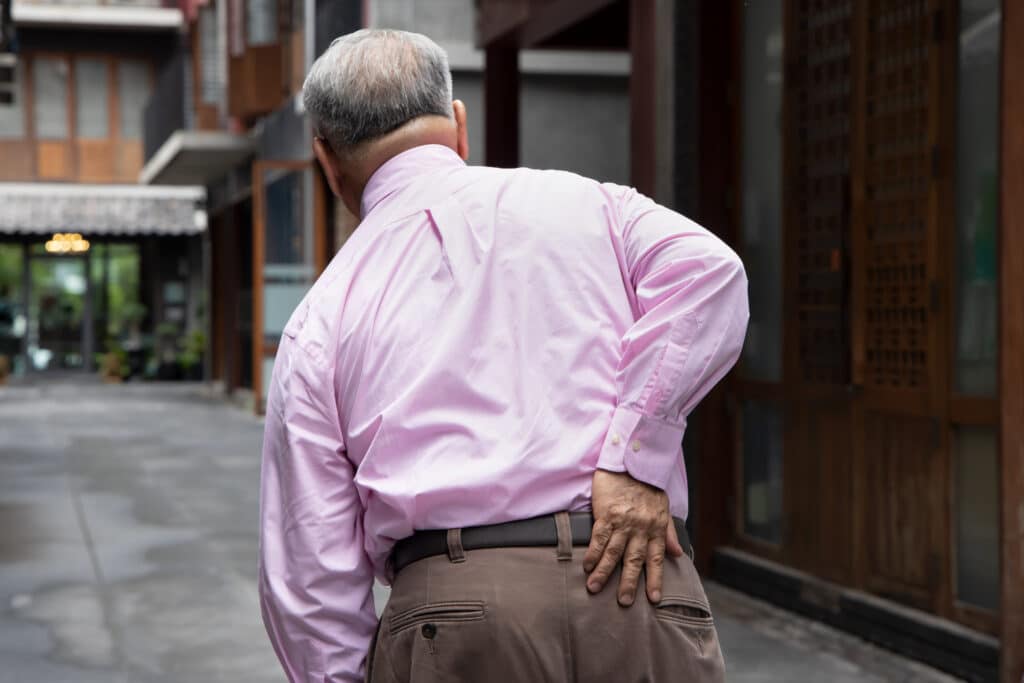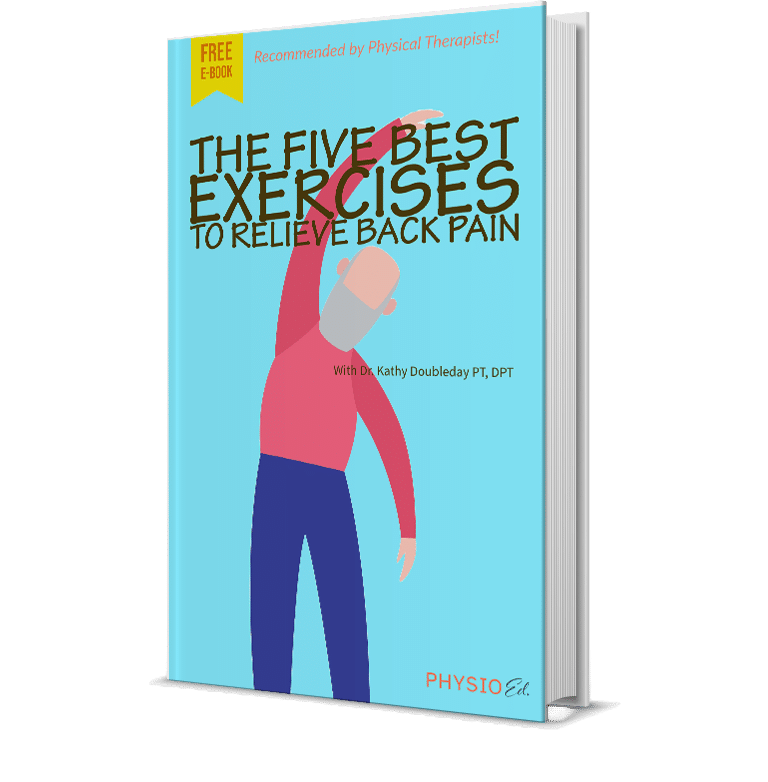Are you or a loved one grappling with the discomfort associated with sciatica? You’re certainly not alone. Sciatica, often identified by its signature symptom of one-sided, radiating leg pain, can pose significant daily problems for active adults.
However, once you’ve identified sciatica as the cause behind your pain and ruled out any serious underlying conditions, there are effective strategies to manage it. Fortunately, exercise can be one of the most effective tools to combat sciatic pain.
In this article, we’ll explore practical at-home sciatica exercises for seniors designed to alleviate the pain caused by sciatica, prevent its recurrence, and enhance overall mobility.
Let’s explore how sciatica exercises for seniors can not only lessen pain but make you stronger and more mobile.
A Brief Introduction to Sciatica
Sciatica is a pervasive problem for many active adults. It can have a variety of causes leading to pain and discomfort. But why does sciatica happen?
The sciatic nerve, a major nerve extending from the lower back down the back of each leg, is particularly susceptible to irritation or compression. This can result in symptoms like pain, numbness, or even weakness.
Many patients don’t realize that sciatica is not a standalone condition. Instead, it’s a symptom indicative of an underlying issue. A precise diagnosis of the root cause of the pain is crucial to determine the most suitable treatment methods.1
In the next section, we’ll explore common conditions that can lead to sciatica.
Common Causes of Sciatica Pain
In older adults, the onset of sciatica pain can often be traced back to a handful of common causes. These causes are primarily related to changes in the spine and surrounding muscles that occur with age. Understanding these causes can better equip you to manage and prevent sciatica pain.
Herniated Discs
These are a major cause of sciatica pain. The discs in our spine are made up of a rigid outer ring and a soft inner portion. As we age, these discs can become less flexible and more prone to damage.
Over time, this can result in a condition where the soft inner portion protrudes through the outer ring. This is known as a herniated disc, which can pressure the sciatic nerve, resulting in pain.
Spinal Stenosis
Another common cause is spinal stenosis. This is a condition where the spaces within your spine narrow over time. This narrowing can compress the nerves that travel through the spine, including the sciatic nerve. The result is often a sharp, radiating pain that can be felt in the lower back and down the legs.
Piriformis Syndrome
Neural impingement, also known as piriformis syndrome, is another cause of sciatica pain for many adults. The piriformis muscle is located in the buttock region, and it can sometimes irritate the sciatic nerve. This irritation can cause pain, numbness, and tingling along the path of the sciatic nerve.
Spondylolisthesis
Lastly, spondylolisthesis is a condition that can lead to sciatica. In this condition, one of the spine’s vertebrae slips out of position onto the bone below it. This displacement can compress the sciatic nerve, leading to pain and discomfort.
Understanding these causes can aid in early detection and effective management of sciatica, leading to a better quality of life for our senior community.
Understanding Sciatic Nerve Discomfort
Sciatica symptoms can vary widely in intensity, from a mild, continuous ache to severe, sharp pain. It’s important to note that, typically, sciatica affects just one side of the body.
This discomfort can be felt at any point along the sciatic nerve’s path, which extends from the hip, through the thigh and knee, down to the calf and foot.
Here are some common symptoms to watch out for:
- Pain that radiates from your lower back, through your buttocks, and down the back of your leg. This pain is often described as a “burning” sensation.
- An increase in pain when you cough, sneeze, or apply pressure to one or more areas mentioned above.
- Pain that worsens when you bend forward, twist, or make other movements involving your spine.
- Increased discomfort during prolonged periods of sitting or standing.
- Numbness or tingling in the lower extremity affected by sciatica.
- Weakness in the leg or foot on the side affected by sciatica.
Awareness of these symptoms is critical for early diagnosis and effective management of sciatic nerve discomfort. By understanding these signs, you can take proactive steps towards seeking medical advice and starting appropriate treatment.
Why Seniors Are More Prone to Sciatica

With age, our bodies inevitably experience various changes, some of which can make seniors more susceptible to sciatica.
For instance, our spinal discs gradually lose their water content. This loss of fluidity leads to less flexible discs that are more prone to herniation or bulging. When a disc protrudes, it can press into the sciatic nerve, triggering pain.
Moreover, the development of arthritis in the spine, a common age-related issue, can result in a narrowing of the space surrounding the sciatic nerve. This restricted area can cause the nerve to become irritated, leading to discomfort.
Another factor to consider is the natural decrease in muscle mass and strength that can occur as we get older. This reduction can affect our posture and the overall health of our spine.
Weaker muscles may cause postural changes and increase the risk of injury during activities such as lifting.
It’s also worth mentioning that while tighter muscles can contribute to postural changes, it’s inaccurate to assume that weak muscles will always lead to tightness or increase the likelihood of injury.
These age-related changes collectively contribute to the increased risk of seniors experiencing discomfort related to sciatica. Understanding these factors can aid in prevention and management strategies to maintain a healthier and more comfortable lifestyle as we age.
Common Treatment Options for Sciatica
Thankfully, sciatica symptoms can often be effectively managed at home. By combining selective treatment methods and patience, you may find yourself on the path to recovery sooner than you may have assumed.
For instance, applying a heat pack to your lower back or soaking in a warm bath can provide significant relief. Aim to apply moist heat for 15 to 20 minutes at regular intervals to stimulate blood flow and soothe the muscles in the affected area.
Preventing the recurrence of sciatica involves a regimen of exercises aimed at strengthening the muscles around your spine, abdomen, buttocks, and hips. Also, adding lower back and hamstring stretches to your daily routine can significantly enhance your range of motion. (We’ll delve into some specific stretches and exercises below.)
It’s best to avoid maintaining any prolonged positions that might exacerbate your discomfort. Practicing good posture can also aid in relieving strain on your back. It’s also advisable to avoid heavy lifting as much as possible when you encounter sciatica, and when lifting is unavoidable, be sure to employ proper techniques to protect your back.
If you find your discomfort persists despite these home management techniques, numerous professional treatment options are available.
Here are some of the most common clinical treatments for chronic sciatic discomfort.2
Medications
Over-the-counter pain relievers, such as acetaminophen, are often the first line of defense against sciatica discomfort. These are readily available and can provide temporary relief from the pain.
Your healthcare provider may also recommend non-steroidal anti-inflammatory drugs (NSAIDs) such as ibuprofen or naproxen. These help to reduce inflammation around the sciatic nerve, which can temporarily alleviate pain.
In more severe cases, your healthcare provider may recommend prescription-strength medications. These can include muscle relaxants or narcotics for severe pain. Oral corticosteroids may be prescribed to reduce inflammation and swelling. In some cases, certain anti-seizure medications and antidepressants can help manage chronic pain associated with sciatica.
Corticosteroid Injections
Corticosteroid injections are another treatment option. When administered directly into the area around the inflamed nerve, these injections can effectively reduce inflammation and alleviate pain associated with the affected nerve.
This is a more targeted approach to pain relief, focusing specifically on the area causing discomfort. Still, it may only be practical in some cases.
Physical Therapy
Physical therapy is a non-invasive approach to managing sciatica. This approach focuses on improving your body’s natural strength and flexibility to combat the effects of sciatica.
With a customized program of exercises, posture re-education, and routines to stretch and strengthen your back and core muscles, physical therapy can improve function, alleviate pain, and prevent future sciatica episodes.
Massage Therapy
Massage therapy, especially deep tissue massage, can be a beneficial part of a comprehensive treatment plan for sciatica.
By reducing muscle tension and enhancing range of motion in the affected region, massage can help to alleviate discomfort and improve mobility.
Surgery
Surgery is only considered in rare instances when other treatment options are ineffective.
This could include cases where there’s significant weakness, loss of bladder or bowel control, or persistent and worsening pain unresponsive to other treatments.
Surgery is an invasive option and is typically reserved for the most severe cases of sciatica.
The Role of Exercise

Regular exercise is more than just a way to stay active; it’s a formidable ally in managing sciatica and significantly enhancing your overall quality of life.
As a physical therapist, I consistently advise my patients to avoid prolonged periods of inactivity, which can worsen sciatica and other physical ailments. Studies support exercise as a prevention method, highlighting the transformative impact of regular exercise on low back pain and the persistent discomfort associated with sciatic nerve pain.3
Related Posts
- Sciatica: What is It, and What Makes it Go Away?
- Sciatica Causes and Exercise Treatment
- Physical Therapy for Nerve Pain
- Disk Herniation Printable Exercises [PDF]
- Printable Back Strain Exercises [PDF]
One of the key benefits of exercise is its ability to stimulate blood flow to the areas affected by sciatica, including the sciatic nerve. This increased circulation can speed up the body’s natural healing process, helping to repair damaged tissues and decrease inflammation.
By fostering improved circulation, exercise plays a crucial role in alleviating the pain and discomfort of sciatica.
Exercise also prompts the release of endorphins— your body’s natural pain relievers and mood boosters. Physical activity triggers the release of these chemicals, which not only help to ease pain but also promote an overall sense of well-being.
This natural ‘feel-good’ effect can be particularly beneficial for those dealing with the challenges of sciatica, as it can help manage both physical discomfort and emotional stress.
Our Favorite Sciatica Exercises for Seniors
When we discuss sciatica exercises for Seniors, we’re not just talking about a routine to keep you moving; we’re introducing a potent solution that can actively lessen your pain, enhance your mobility, and uplift your mood.
Here are some of our favorite exercises to combat sciatica to keep you feeling strong and mobile.
Strength-Building Sciatica Exercises for Seniors
One effective way to alleviate sciatica pain is by strengthening key muscle groups. By focusing on your core, glutes, and lower back, you can provide better support for your spine. Here are a few exercises to consider:
Pelvic Tilts
- Begin standing tall with your knees slightly bent.
- Engage your abdominal muscles, tilting your pelvis upward like you’re trying to bring your beltline closer to your chin.
- Maintain this position for 5 seconds before releasing. Aim to repeat this exercise 10 times.
Bridges
- Start lying on your back with your knees bent and your feet flat on the floor.
- Lift your hips off the ground, forming a straight line from your shoulders to your knees, and squeeze your gluteal muscles.
- Hold this position for 5 seconds before lowering down.
- Perform ten repetitions, then rest. Repeat as needed.
Incorporating warm-up and cool-down exercises at the start and end of your routine can also help prevent injuries, which can be as simple as taking a short walk or doing five to ten sit-to-stand squats.
It’s important to note that these extension-based exercises may not suit everyone. If you have spinal stenosis, these exercises may not be recommended. Talk to your physical therapist if you are living with this condition.
Gentle Stretching Exercises for Sciatica for Seniors
Stretching exercises can be a beneficial method to alleviate the discomfort caused by the tension in the muscles surrounding the sciatic nerve.
Here are some easy-to-do, gentle stretches that can help.
Knee-to-Chest Stretch
- Start by lying flat on your back and gently pull one knee towards your chest, holding the position for about 20 seconds.
- Release, then repeat with your other knee.
- Perform this stretch 3 times for each leg, and take your time to avoid any strain or irritation.
Piriformis “Figure Four” Stretch
- For this stretch, sit at the edge of a chair with one leg crossed over the other.
- With your back flat, gently lean forward. You should begin to feel this stretch in your buttocks.
- Hold this position for about 20 seconds before switching to the other side.
- Like the first exercise, aim to do this stretch three times for each leg.
Optimal Low-Impact Cardiovascular Exercises
Cardiovascular exercises are known for their ability to enhance circulation and activate your muscles. They are a crucial component of maintaining a healthy lifestyle, and they can be helpful to improve blood flow to areas affected by sciatica.
For low-impact options, here are some joint-friendly exercises that can help to lessen your sciatica discomfort.
Swimming is an excellent low-impact exercise that uses the natural buoyancy of water to reduce strain on your joints. As a bonus, it provides a comprehensive workout for your entire body, making it a very efficient exercise.
Walking, whether a brisk stroll in the park or a leisurely walk around your neighborhood, can significantly improve circulation and strengthen your leg muscles. However, it’s important to note that if you plan on walking for extended distances, you may need to take breaks periodically to prevent exacerbating your sciatica.
Stationary Biking is another fantastic low-impact exercise option. The stationary bike is designed to minimize joint stress while still providing an excellent cardiovascular workout. The best part is you can customize the resistance to suit your individual fitness level.
In any exercise routine, it’s crucial to pay attention to your body’s signals. If you experience any discomfort or pain during an exercise, it’s imperative to stop immediately.
Consulting with a healthcare professional or physical therapist before starting a new exercise routine is highly recommended, especially for those with pre-existing health conditions. They can provide valuable guidance and ensure your training is safe and effective for your needs.
Knowing When to Seek Medical Advice
While staying active is a critical component of managing conditions like sciatica, it’s equally crucial to understand when to seek advice from a healthcare professional.
If you notice that your pain intensifies during exercise or if you start experiencing new or uncommon symptoms, it’s time to consult a healthcare expert.
Additionally, if you have pre-existing health issues or are new to exercise, professional guidance can be beneficial.
Key Takeaways
- Sciatica is a common issue for many active adults, often caused by irritation or compression of the sciatic nerve.
- Common causes of sciatica pain include herniated discs, spinal stenosis, neural impingement, and spondylolisthesis.
- Sciatica symptoms can vary but often include radiating pain, increased discomfort during prolonged periods of sitting or standing, and numbness or tingling in the affected area.
- Age-related changes can increase the risk of seniors experiencing sciatica discomfort.
- Common non-exercise treatment options for sciatica include medications, corticosteroid injections, physical therapy, massage therapy, and, in rare cases, surgery.
- Regular exercise can be a highly effective method to manage sciatica, stimulate blood flow to affected areas, and enhance overall mobility.
- It’s crucial to seek medical advice if pain intensifies during exercise, new or uncommon symptoms arise, or if you have pre-existing health issues.
FAQs
For older adults, sciatica can be triggered by a variety of factors. The most common cause is spinal degeneration due to aging, which can lead to conditions like herniated discs, lumbar spinal stenosis (narrowing of the spinal canal), and spondylolisthesis (one vertebra slipping over another).
Other risk factors include a sedentary lifestyle, being overweight, diabetes, and osteoarthritis. Acute injuries from falls or improper lifting can also precipitate sciatica.
Do sciatica symptoms resolve without the need for intervention?
In many cases, sciatica symptoms can improve over time without surgical intervention. The natural course of sciatica is favorable for many individuals, and symptoms often lessen or resolve within a few weeks to a few months.
Non-surgical interventions such as physical therapy, anti-inflammatory medications, and epidural steroid injections can also help manage and alleviate symptoms.
What specific physical therapy techniques are used to treat sciatica in seniors, and how effective are they?
Physical therapy can be quite effective for treating sciatica in seniors. Therapists use gentle exercises to stretch and strengthen the muscles of the back and abdomen, which can help take pressure off the sciatic nerve. They also use hands-on techniques to help relieve pain and improve movement.
Additionally, they teach seniors how to sit, stand, and move in ways that protect their backs and prevent future pain. This combination of exercises, hands-on care, and education can significantly reduce sciatica symptoms for many older adults.
How long will my sciatica pain last?
The duration of sciatica pain can vary widely. Many people experience relief within 4 to 6 weeks, but for some, the pain can last much longer.
Chronic sciatica can persist for several months. The duration often depends on the underlying cause and the effectiveness of the treatment regime. If symptoms are severe or persist, it is important to seek medical advice.
Can exercise help me cope with sciatica?
Yes, exercise can benefit individuals with sciatica, primarily when it focuses on strengthening the back and abdominal muscles, improving flexibility, and promoting proper posture.
However, it is essential to consult with a healthcare professional or physical therapist to get a tailored exercise program, as specific exercises may not be suitable for everyone, and some can even exacerbate sciatica if done improperly.
References
- Hawkins, K., Musich, S., Bottone Jr, F. G., Ozminkowski, R. J., Cheng, Y., Rush, S., … & Yeh, C. S. (2013). The impact of pain on physical and mental quality of life in adults 65 and older. Journal of gerontological nursing, 39(6), 32-44.
- Ferreira, M. L., & McLachlan, A. (2016). The challenges of treating sciatica pain in older adults. Drugs & Aging, 33(11), 779-785.
- Rainville, J., Hartigan, C., Martinez, E., Limke, J., Jouve, C., & Finno, M. (2004). Exercise as a treatment for chronic low back pain. The Spine Journal, 4(1), 106-115.




